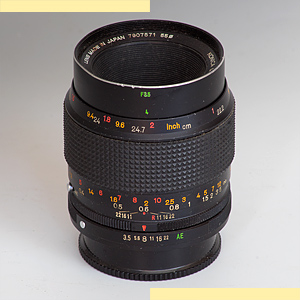Anders als die meisten Makro-Normalobjektive der Konkurrenz, die üblicherweise fünflinsige Xenotare oder sechslinsige Planare sind, ist das Macro-Hexanon AR 3.5/55mm ein Tessar-Typ und demzufolge aus nur vier Linsen aufgebaut. Zudem ist das AR 3.5/55mm das einzige Makro-Objektiv von Konica, das einen eigenen Schneckengang aufweist. Konica hatte nebst dem 55mm Macro nur noch einen für Balgengeräte gebauten 4/105mm Objektivkopf, der wie die meisten damaligen Makros der 100mm-Klasse als Heliar ausgelegt war. Anders als Canon und Nikon bot Konica nie ein manuelles 200mm Makro an, und auch eigentliche Mikro-Objektive (quasi Mikroskop-Objektive mit Blendenmechanismus) waren von Konica nicht erhältlich. Canon, Minolta und Olympus waren diesbzüglich also besser ausgestattet.
Das Konica AR 3.5/55mm Macro wurde ab ca. in drei kosmetisch leicht unterschiedlichen Varianten gebaut; es hatte aber von Beginn weg den gummierten Fokusring. Die Fassung ist sehr wertig gebaut und mit zahlreichen präzise ausgeführten Gravierungen ausgestattet, die insbesondere die Blitz-Belichtungssteuerung in der "vor-TTL-Zeit" vereinfachen sollten.
Ungewöhnlich ist, dass das 3.5/55mm Makro um 180° gedreht in den mitgelieferten 1:1-Adapter eingeklinkt wird. Damit wird eine komplette zweite Gravierung sichtbar, die nun an die Gegebenheiten zwischen Massstab 1:2 und 1:1 angepasst ist. So geht die Blendenreihe am Blendenring nun von f5.2 bis f32 (statt f3.5 bis f22), und die bei der jeweiligen Vergrösserung wirksame effektive Lichtstärke (von f5.2 bei 1:1 bis f7.0 bei 1:1) lässt sich einfach an der Fassung ablesen.
Überraschenderweise ist die Leistung des Macro-Hexanons sowohl im Unendlich-Bereich als auch bei 1:10 praktisch auf dem Level des Canon (n)FD 3.5/50mm, des Minolta MC/MD 3.5/50mm und des Micro-Nikkor 3.5/55mm (getestet an 24 MP FF). Im Unendlichen ist das Zentrum bei Offenblende noch deutlich "weich", und longitudinale CAs ("purple fringing") sind zumindest an 43 MP FF Kameras deutlich sichtbar. Die Ecken kommen etwas unscharf. Abgeblendet auf f5.6 ist das Zentrum hervorragend aufgelöst, aber weiten Teilen des Bildfeldes fehlt immer noch der knackige Kontrast, den z. B. das Minolta 3.5/50mm auszeichnet. Dies ändert sich bei Abblendung auf f11, und nun kann das Konica AR 3.5/55mm Macro bedenkenlos für Landschaften eingesetzt werden. Gerade die Bildecken werden aber von AR 1.7/50mm dennoch besser aufgelöst (43 Mp FF).
Bei einem Massstab von 1:10, auf den das Objektiv vermutlich ausgelegt wurde, zeigt das AR 3.5/55 schon bei f5.6 eine exzellente Leistung. Einzig bei f3.5 müssen wir mit etwas reduziertem Kontrast rechnen, was aber gerade bei Pflanzen und Blüten durchaus willkommen ein kann.
Unlike most other Macro lenses in the 50-55mm range, the Konica Hexanon AR 3.5/55mm is a simple Tessar type with only four lenses in three groups. The Canon FD 3.5/50mm Macro and the Nikkor 3.5/55mm Micro both have five lenses (but differing configurations), and the Minolta Rokkor 3.5/50mm is a classical Planar type with six lenses in four groups. The AR 3.5/55mm was the only Konica macro lens which had its own focusing mechanism. There is a AR 4/105mm Macro for bellows as well, but that's it. No 200mm Macro, and no Micro lenses were available from Konica!
Right from the beginning the Konica AR 3.5/55mm Macro was delivered with a rubber focusing grip. Three sub-variants with minor cosmetic differences can be found: an early one with a chrome ring near the aperture ring, and two completely black versions with either yellow "EE" or green "AE" markings. The lens barrel itself is very well built, and focusing goes from infinity to 1:2. An additional adapter for the 1:2 to 1:1 range was included in the set.
All engravings are very nicely machined. Interestingly, the lens has two different sets of engravings, one on the top side for normal use, and one on the lower side for use with the 1:1 adapter. If the lens is mounted into the 1:1 adapter, those "lower side" engravings are now on top, thus facilitating the use of flash exposure metering considerably (this was pre-TTL!).
The Hexanon performs surprisingly well both at infinity as well as 1:10. At infinity, its corner resolution is nearly as good as the Canon and the Nikkor, and at f5.6 even slightly better than the Minolta (at f11 the Minolta is better again).
At infinity and f3.5, the AR 3.5/55mm Macro is somehow soft. Longitudinal CAs ("color fringing") are visible all over the frame. Stopping down to f5.6 results in excellent center performance, but large parts of the images still have a somehow low contrast. At f11 the image looks excellent (43 MP FF), and only the corners are still slightly "unsharp". The AR 1.7/50mm doesn't have these limitations, but the Macro certainly can be used for high res landscapes as well.
At 1:10 (for which the lens probably was designed) the performance is excellent from f5.6 on. Wide open the lens has a lower contrast, but that can be quite desirable e. g. for plant an flower photography.
 |
 |
KONICA HEXANON 55mm 1:3.5 (4 Linsen / 3 Glieder) |

